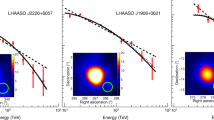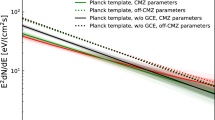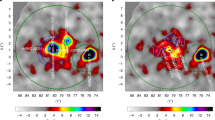Abstract
Recent measurements of the charge and energy composition of cosmic rays have shown the energy spectra of secondary cosmic ray nuclei (Li, Be, B) to be steeper than those of the parent nuclei (C, O) indicating a decreasing path length for the particles with increasing energy. Differences also exist in the energy spectra of primary nuclei such as C, O and Fe. Of particular interest is the spectrum of Fe above 100 GeV. Measurements exist up to ∼1013eV (refs 1, 2), and these indicate that the spectrum of Fe is less steep than that of lighter nuclei including protons. If this trend were to continue to ⩾1015eV, Fe would then become the dominant constituent of cosmic rays. This conclusion is supported by results from air shower measurements at primary energies >1013eV (refs 3–5). However, air shower measurements suffer from the inherent uncertainty of having to extrapolate data from lower energy accelerator measurements for air shower modelling6. Thus these results need confirmation by direct measurements of Fe nuclei. We describe here results from such an experiment.
This is a preview of subscription content, access via your institution
Access options
Subscribe to this journal
Receive 51 print issues and online access
$199.00 per year
only $3.90 per issue
Buy this article
- Purchase on Springer Link
- Instant access to full article PDF
Prices may be subject to local taxes which are calculated during checkout
Similar content being viewed by others
References
Simon, M. et al. Astrophys. J. 239, 712–724 (1980).
Balasubrahmanyan, V. K. Proc. 16th int. Conf. Cosmic Rays, Kyoto 14, 121–134 (1979).
Goodman, J. A. et al. Phys. Rev. Lett. 42, 854–857 (1979).
Cowsik, R. et al. Proc. 17th int. Conf. Cosmic Rays, Paris 2, 120–123 (1981).
Thornton, M. & Clay, R. J. Phys. G5, L137–L140 (1979).
Gassier, T. K. & Yodh, G. B. A. Rev. nucl. part. Sci. 30, 475–542 (1980).
Sitte, K. Proc. 9th int. Conf. Cosmic Rays 2, 887–889 (1965).
Gough, M. P. J. Phys. G2, 965–969 (1976).
Sood, R. & Panettieri, J. Nucl. Instrum. Meth. 185, 427–431 (1981).
Koch, L. et al. Proc. 17th int. Conf. Cosmic Rays, Paris 2, 18–21 (1981).
Klarmann, J. et al. Proc. 17th int. Conf. Cosmic Rays, Paris 2, 13–16 (1981).
Simon, M. et al. Proc. 16th. int. Conf. Cosmic Rays, Kyoto 1, 352–357 (1979).
Orth, C. D., Buffington, A., Smoot, G. F. & Mast, T. S. Astrophys. J. 226, 1147–1161 (1978).
Juliusson, E. Astrophys. J. 191, 331–348 (1974).
Meyer, P. & Minnagawa, G. Proc. 16th. int. Conf. Cosmic Rays, Kyoto 1, 329 (1979).
Hillas, A. M. Proc. 16th. int. Conf. Cosmic Rays, Kyoto 8, 7–12 (1979).
Cowsik, R. & Wilson, L. Proc. 14th int. Conf. Cosmic Rays, Munich 2, 659–664 (1975).
Author information
Authors and Affiliations
Rights and permissions
About this article
Cite this article
Sood, R. Detection of 1014-eV iron nuclei in cosmic rays. Nature 301, 44–46 (1983). https://doi.org/10.1038/301044a0
Received:
Accepted:
Issue Date:
DOI: https://doi.org/10.1038/301044a0
This article is cited by
Comments
By submitting a comment you agree to abide by our Terms and Community Guidelines. If you find something abusive or that does not comply with our terms or guidelines please flag it as inappropriate.



